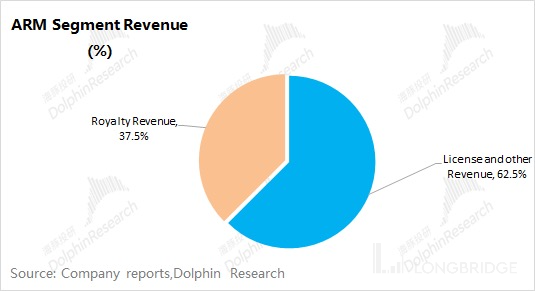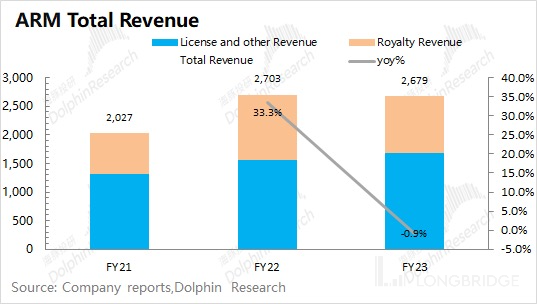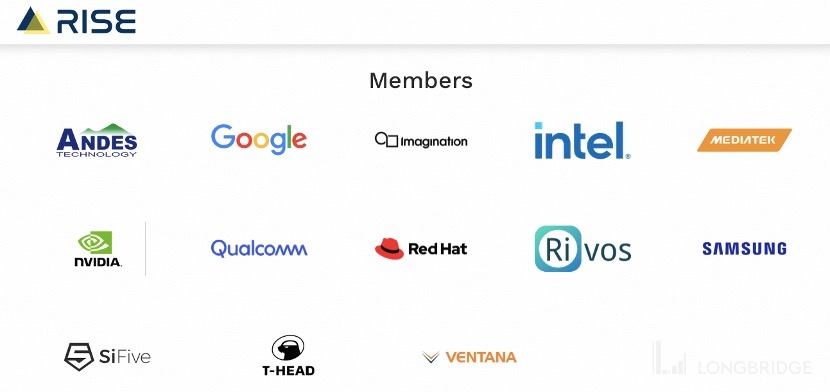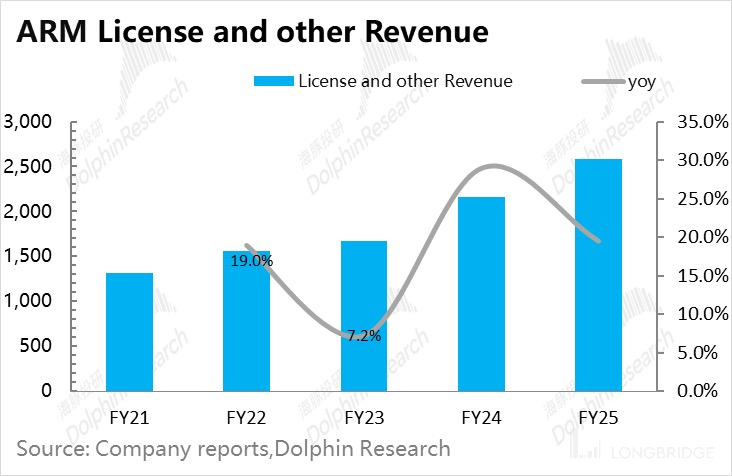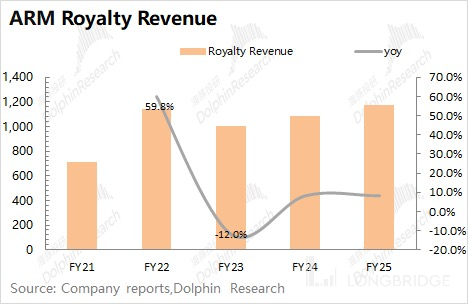
 Likes Received
Likes Received Posts
PostsARM: After selling Alibaba, is SoftBank's next cash cow really worth 50 billion dollars?

After NVIDIA abandoned the acquisition, ARM had no choice but to go public on its own. This seemingly "helpless" move actually increased ARM's valuation by over $10 billion. ARM Holdings PLC ADR.US is also expected to become the largest IPO this year.
What kind of company is ARM that Apple, NVIDIA,$AMD(AMD.US), Taiwan Semiconductor.US, Alphabet.US, and other major US tech giants are competing to become cornerstone investors, pushing the valuation of this IPO to over $50 billion?
In general, Dolphin Research believes that ARM is indeed an important player in the global semiconductor industry chain, especially in the smartphone market, where it dominates the two major customer camps of iPhone and Android systems, almost monopolizing the market. However, this "monopoly" position has not given the company the corresponding discourse power.
Under relatively optimistic assumptions, Dolphin Research believes that if the company only focuses on the smartphone market, it already has an absolute leading market share, making it difficult to achieve significant growth. This, along with other factors, has kept the company's valuation suppressed below $50 billion.
Now, considering the company's compound growth rate of 20-30% over the next two years and a PE ratio of nearly 60 times after two years, Dolphin Research believes that the current IPO valuation of $50 billion has already incorporated relatively optimistic expectations from a long-term perspective.
Of course, this IPO has attracted star industry shareholders, which may increase the emotional valuation. However, Dolphin Research suggests considering securing certain short-term gains if participating in the IPO. Below is Dolphin Research's specific analysis of ARM (ARM.O):
1. Talking about ARM
ARM was established in 1990 as a joint venture between chip companies Acorn, Apple, and VLSI. Apple invested £1.5 million, VLSI invested £250,000, and Acorn contributed £1.5 million in intellectual property and 12 engineers.
Initially, ARM focused on chip design. After a few years of struggling to grow the business, the company decided to change its strategy. ARM shifted from chip production to licensing its chip design solutions to other manufacturers. This change in direction opened up a new era for ARM.
According to the filing submitted by ARM, the company's main sources of revenue are licensing fees and licenses, collaborations, and other income. Licensing fees make up the largest portion of the revenue, consistently accounting for about 60% of the total. So, what is the difference between these two types of revenue?
1) License and other Revenue: IP licensing fees. This refers to ARM licensing its chip design solutions (IP) to companies like Apple and Qualcomm and charging licensing fees. However, these fees are one-time fees, but they are charged annually, similar to "rent."
2) Royalty Revenue: Royalty income. This refers to customers using ARM's chip design solutions (IP) to produce chips. When customers' chips are sold, they pay ARM a royalty based on a certain percentage.
ARM's stable rental income model appears quite robust. SoftBank recognized this and privatized ARM with a premium of approximately 43%. However, after the acquisition, SoftBank found that although the company's business model was good, it was difficult to achieve rapid performance improvement.
ARM was acquired by SoftBank for $32 billion, and even after several years, its annual profit is still less than $600 million. Faced with sluggish profit growth, the market has always had a mediocre valuation of ARM. After all, SoftBank is an investment company, and they began to consider selling ARM.
2. Does ARM have a moat?
After SoftBank planned to "sell" ARM, NVIDIA showed interest in "taking over." From the fact that the computing power "giant" was willing to offer $40 billion for the acquisition, it is evident that ARM is still valuable. However, this plan was eventually halted by regulatory authorities. For SoftBank, selling this lukewarm company for $40 billion is still profitable. But what does NVIDIA think?
Although ARM's performance is average, it holds a dominant position in the smartphone market. Both the iPhone and Google's Android system use the ARM instruction set. Since NVIDIA already has a leading position in the PC GPU market, if it can acquire ARM, NVIDIA could potentially dominate both the PC and smartphone markets, further solidifying its monopoly. This is a key reason why regulatory authorities ultimately halted the deal.
What can ARM provide? By adopting the ARM architecture, downstream customers can optimize chip designs according to their own needs. The ARM architecture to some extent allows for:
Especially for companies like Apple, choosing to collaborate with ARM can mitigate some risks if they were to design chips from scratch. In other words, it's like ARM has already provided the "hard furnishings" and Apple only needs to focus on the "soft furnishings," greatly simplifying the risk and cost of chip design.
With its outstanding "hard furnishings," ARM has established partnerships with global chip giants such as Apple, Qualcomm, and NVIDIA, greatly expanding ARM's ecosystem. And as more and more users adopt the ARM architecture, the number of ARM developers and users will also increase. With the improvement of the ecosystem, new users will be willing to use the ARM architecture, further accumulating its advantages.
But is ARM's moat really getting stronger? Not really. Although ARM currently holds a monopoly position in the smartphone field, it is not invincible.
- Lack of bargaining power
In 2022, ARM had a dispute with Qualcomm over licensing fees. ARM intended to renegotiate the agreement to increase licensing fees, but Qualcomm refused to accept it. In the face of ARM's near-monopoly position, Qualcomm began to seek alternative solutions. The dispute between ARM and Qualcomm has made other customers alert and they have started looking for alternatives.
- Failure of bundling strategy
Starting from 2025, ARM plans to require ARM CPUs to be equipped with ARM's GPU, NPU, and ISP. Once this news came out, major downstream customers began to develop their own architectures, making it difficult to achieve a bundled ecosystem.
Overall, ARM's dominance in the smartphone market is not unbreakable. In the first half of 2023, 13 companies including Samsung, Intel, and Qualcomm jointly established RISE, mainly to build the software ecosystem for RISC-V and further reduce dependence on ARM. Similar to ARM, RISC-V adopts a reduced instruction set and an open-source approach.

From the perspective of price increases and bundled customer reactions, although ARM currently holds a leading industry position, its downstream customer base lacks sufficient influence in the industry chain. The difficulty in raising prices for its products has hindered ARM's ability to achieve high-speed growth.
Third, is ARM worth 50 billion?
After being integrated into the iPhone, the ARM instruction set has also entered Google's Android system, firmly establishing ARM's monopoly position in the global smartphone market. However, the establishment of RISE to some extent indicates that ARM is not indispensable in the industry chain.
Prior to the IPO, major customers such as Apple, Nvidia, and Qualcomm have all invested in ARM, and the company's valuation has exceeded 50 billion US dollars. Is ARM really worth it? From the perspective of performance and valuation, Dolphin Research evaluates the value of ARM.
3.1 Performance Perspective
In evaluating performance, the main factors considered are revenue, gross margin, and operating expenses.
- Revenue: As mentioned earlier, the company's revenue mainly consists of one-time IP licensing fees and royalty income. Therefore, these two components need to be analyzed separately.
a) One-time IP licensing fees: This refers to the one-time fees charged by the company for authorizing the use of chip design solutions (IP) by customers. It can be divided into comprehensive licensing (allowing the use of the latest developed features and services) and flexible licensing.
Based on industry information and company data, Dolphin Research makes relatively optimistic assumptions. It is expected that the company's one-time IP licensing fees will achieve revenue of nearly 2.5 billion US dollars in the fiscal year 2025, achieving double-digit compound growth. b) Royalty Income: This mainly refers to the royalties collected from the production of chips utilizing ARM IP. The income is closely related to the chip shipments of the company's clients.
Based on industry information and company data, Dolphin Research makes relatively optimistic assumptions. It is estimated that the royalty income for the fiscal year 2025 is expected to reach nearly $1.2 billion, achieving a high single-digit compound growth rate.
2) Gross Margin and Expense Ratio:
a) Due to its asset-light nature, ARM maintains a high gross margin, consistently above 90%. Considering the company and industry conditions, Dolphin Research expects the company's gross margin to continue to be around 95%;
b) ARM's expense ratio has also remained at a high level, mainly due to the significant research and development investment required by its high-tech nature. Dolphin Research assumes that the company's R&D expense ratio will continue to be around 40%, while the sales and administrative expense ratio will be maintained at around 30%.
3) Profitability: Based on Dolphin Research's assumptions about ARM, in a relatively optimistic scenario, it is estimated that ARM's profit will reach nearly $900 million by 2025, with an annual compound growth rate of nearly 30%.
3.2 Valuation and Pricing
Based on the performance estimation, ARM is expected to continue its decent growth momentum in the future.
Dolphin Research believes that if we only consider the smartphone market, the company already has an absolute leading market share, making it difficult to achieve significant improvement. This limitation has been one of the important reasons why the company's valuation has been suppressed below $50 billion.
The current high valuation at the time of the IPO is more due to the favorable market conditions: driven by technologies such as AI, the market's attention to the company has significantly increased, leading to an increase in valuation. However, ARM's competitiveness in the cloud computing and network equipment markets is not outstanding, and it still has relatively few customers and market share.
Considering the company's future compound growth rate of 20-30% over the next two years and a PE ratio of nearly 60x after two years, Dolphin Research believes that the current valuation of $50 billion in the IPO already incorporates some relatively optimistic valuations. If there is a certain short-term gain from participating in the IPO, it may be worth considering to secure the profit.
Dolphin Research Semiconductor Industry Chain and Related ResearchSemiconductor Industry
March 7, 2023 - "NVIDIA: Will There Be a Big Turnaround After the Magical Performance?"
December 29, 2022 - "Semiconductor Avalanche? Real Resilience Comes After the Most Brutal Decline"
June 24, 2022 - "Order Cancellations, Is the Semiconductor Industry Really Going to 'Change'?"
June 17, 2022 - "Consumer Electronics 'Matured', Apple Stands Strong, Xiaomi Struggles"
TSMC in Depth
April 8, 2022 - "TSMC (Part 2): Discounted Prices, Unwavering Faith"
March 16, 2022 - "After the Market Crash, Let's Talk About the Ashes-to-Ashes Foundry King TSMC Again"
In-depth Analysis of NVIDIA
September 16, 2021 - "NVIDIA (Part 1): How Did the Chip Giant Achieve a Twentyfold Growth in Five Years?"
September 28, 2021 - "NVIDIA (Part 2): No Longer Driven by Dual Wheels, Will Davis Double Kill?"
SMIC in Depth
July 16, 2021 - "SMIC (Part 2): The Underestimated Chinese 'Core'"
July 9, 2021 - "SMIC (Part 1): The Strategy of the Leading 'Core'"
Risk Disclosure and Statement for this Article: Dolphin Research Disclaimer and General Disclosure
The copyright of this article belongs to the original author/organization.
The views expressed herein are solely those of the author and do not reflect the stance of the platform. The content is intended for investment reference purposes only and shall not be considered as investment advice. Please contact us if you have any questions or suggestions regarding the content services provided by the platform.

